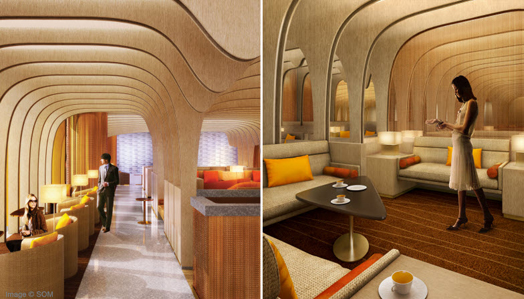Compiled by Team
IAnD
Photography: Courtesy the architects
Photography: Courtesy the architects
 |
| . |
India’s commercial capital, Mumbai’s stunning
new GVK
Chhatrapati Shivaji International Airport Terminal 2 designed
by Skidmore, Owings & Merrill (SOM) architects is a delightful unification of
Indian art and design.
.jpg) |
| . |
Inaugurated on Jan.10, 2014, the new elongated X-shaped air hub orchestrates the complex web of passengers and planes into a design that feels intuitive and responds to the region’s rocketing growth. The new terminal combines international and domestic passenger services under one large roof (one of the largest in the world without an expansion joint), optimizing terminal operations and reducing passenger walking distances.
.jpg) |
| . |
The long-span capabilities of the steel truss structure
allow for the spacing of thirty 130-foot columns, generating a large
column-free central podium, reminiscent of the airy pavilions and interior
courtyards of traditional regional architecture. Small disks of colourful glass recessed within the canopy’s
coffers speckle the hall below with light, referencing the peacock, the
national bird of India, and the symbol of the airport.
Rather than compartmentalizing terminal functions, three symmetrical concourses radiate outwards from a central processing core or ‘headhouse’ that sits atop highly adaptable and modular concourses, which in turn are therefore easily reconfigured to “swing” between serving domestic flights or international flights, maximizing the terminal’s perimeter for aircraft gates.
Terminal 2 uses a high-performance glazing system with a
custom frit pattern to achieve optimal thermal performance and mitigate glare.
Perforated metal panels on the terminal’s curtain wall filter the low western
and eastern sun angles, creating a comfortable day-lit space for waiting
passengers, and responsive daylight controls balance outdoor and indoor light
levels for optimal energy savings. Strategically-placed skylights throughout
the check-in hall are said to reduce the terminal’s energy usage by 23%, while a
50-foot-tall glass cable-stayed wall—the longest in the world creates a transparent
façade, going back to times of yore, allowing accompanying well-wishers to
watch as their friends and family depart.
 |
| . |
Just as the four-storey terminal celebrates a new global, high-tech identity for Mumbai, the structure is imbued with responses to the local setting, history, and culture. Ace Indian fashion designers Abu Jani and Sandeep Khosla, known for their distinctive flair for Indian designs have created the interiors that reflect heavy use of Indian textiles. Culturally referential fixtures and details, such as custom chandeliers inspired by the lotus flower and traditional mirror mosaic work created by local artists, over 6000 artefacts sourced from across India, and a mammoth art project featuring 1500 artists, elevates the ambience of terminal beyond the typical, often unimaginative airport experience.
With modern materials and technologies and cutting-edge
strategies setting a new standard for sustainable, modern airport design, the
terminal is as much a showpiece of the history and traditions of India and
Mumbai, as it is an unprecedented structural and technological
achievement.

.jpg)
.jpg)
fantastic structure!
ReplyDeleteI have been exploring for a bit for any high-quality articles
ReplyDeleteor weblog posts in this kind of area . Exploring in Yahoo I ultimately stumbled upon
this site. Studying this information So i'm satisfied to exhibit that I've an
incredibly just right uncanny feeling I found out
just what I needed. I so much certainly will make certain to do not
put out of your mind this web site and provides it a glance regularly.
I like viewing web sites which comprehend the price of delivering the excellent useful resource free of charge. I truly adored reading your posting. Thank you! zanzibar airport transfers
ReplyDelete